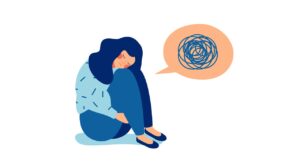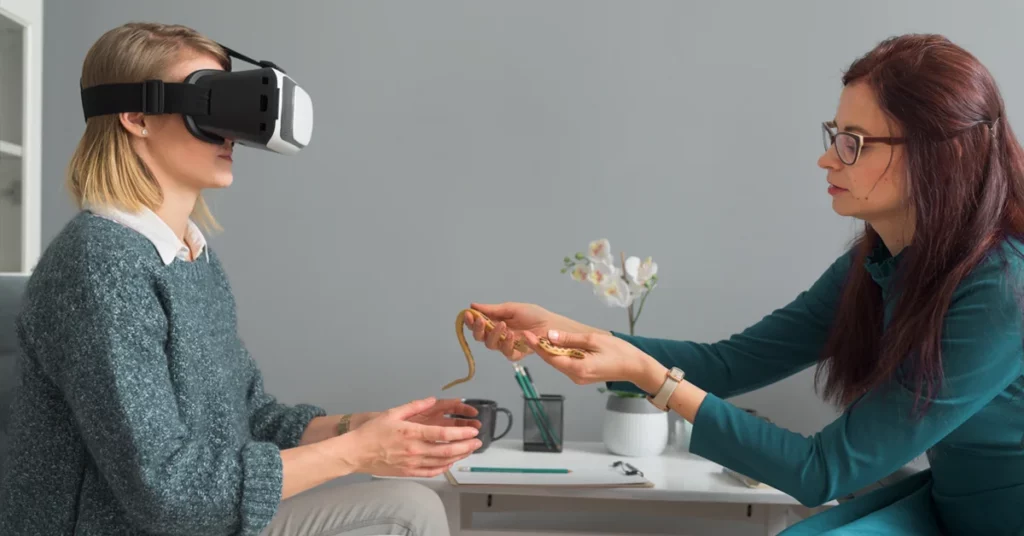Exposure therapy has been found to be effective in the treatment of panic disorder. It involves exposing the person with panic disorder to the things they fear most, in a safe and controlled environment. This helps them learn that these things are not actually dangerous, and eventually reduces the anxiety and fear associated with them. In this blog post, we will discuss exposure therapy in more detail, and how it can help people suffering from panic disorder.
Contents
- 1 What Is Exposure Therapy?
- 2 What Are The 4 Principles Of Exposure Therapy For Panic Disorder?
- 3 What Can You Expect From A Session?
- 4 How Long Does Exposure Therapy Take To Work?
- 5 Can Panic Disorder Be Fully Cured?
- 6 How Do I Start Exposure Therapy For Panic Disorder?
- 7 What Is The Success Rate Of Exposure Therapy For Panic Disorder?
- 8 Conclusion
What Is Exposure Therapy?
 Exposure therapy is a type of cognitive behavioral therapy (CBT) that helps individuals confront and manage their fears. This happens by gradually introducing them to the situations, people, or objects that trigger those fears. Through this process, people can learn how to cope with their anxieties in a safe environment. And develop healthier responses when they are presented with similar triggers.
Exposure therapy is a type of cognitive behavioral therapy (CBT) that helps individuals confront and manage their fears. This happens by gradually introducing them to the situations, people, or objects that trigger those fears. Through this process, people can learn how to cope with their anxieties in a safe environment. And develop healthier responses when they are presented with similar triggers.
This therapy type is based on the idea that the more an individual is exposed to the feared stimulus, the less anxious they will become. This can lead to lasting changes in how people react to and manage their anxiety levels.
So, if you want to consider exposure therapy for panic disorder, be sure to consult with a professional. They can help guide you through the process, create a plan tailored to your individual needs, and provide support during the course of treatment. With the right guidance, exposure therapy can be a powerful tool for overcoming anxiety.
What Are The 4 Principles Of Exposure Therapy For Panic Disorder?
The four principles of exposure therapy for panic disorder are:
1. Habituation: It is one of the first principles that believe repetitive exposure to different triggers and terrifying situations helps reduce the intensity of the fear associated with it. For example, by exposing the patient to a trigger such as being in a crowded room, they will become more comfortable with the situation over time.
2. Extinction: The next principle is extinction, which involves gradually decreasing the intensity or duration of the exposure to a stimulus. For example, if a patient is scared of snakes, they may start by looking at pictures of snakes, then gradually move on to being in the same room as a snake, and eventually touch the snake.
3. Emotional processing: This is another important principle, as it involves learning how to manage and control one’s emotions in a healthy way. This can include techniques such as mindfulness, cognitive restructuring, and problem-solving.
4. Self-efficacy: Finally, most exposure therapy programs also involve building up the patient’s self-efficacy, which is the belief that one can handle different situations and challenges. It works by gradually increasing the difficulty of exposure tasks, so the patient learns to manage and be comfortable with more difficult situations.
By following these principles, exposure therapy can help individuals suffering from panic disorder manage their symptoms and eventually lead a more comfortable life.
What Can You Expect From A Session?
 When you are going to attend an exposure therapy session for panic disorder, you can expect different things. For example, you can expect to have a discussion with your therapist about what triggers the panic attack. As well as techniques that may help you manage the symptoms.
When you are going to attend an exposure therapy session for panic disorder, you can expect different things. For example, you can expect to have a discussion with your therapist about what triggers the panic attack. As well as techniques that may help you manage the symptoms.
During each session, your therapist may ask questions about your life and feelings. In order to gain a better understanding of how panic disorder affects you. Additionally, your therapist may also provide education about panic disorder, teach you breathing and relaxation techniques, and provide strategies for managing panic symptoms.
At the end of each session, your therapist will provide feedback about your progress and may assign “homework” tasks. That you can practice in order to reduce your symptoms. Homework may include exposure activities such as writing down thoughts related to panic. Or maybe practicing progressive muscle relaxation.
Overall, exposure therapy sessions for panic disorder provide a safe and supportive environment to discuss your experiences. And gain more control over the symptoms of your condition. With consistent practice and dedication, you can expect to learn techniques that will help reduce the frequency and intensity of your panic attacks.
How Long Does Exposure Therapy Take To Work?
Panic disorder is really hard to treat, but exposure therapy can help. It is a type of therapy that works by gradually introducing the patient to their fear until they become desensitized to it. This process can take anywhere from several weeks or months depending on the severity and complexity of the disorder.
In some cases, the treatment could take up to a year or more depending on the individual’s ability to cope with their fear. During this time, the patient will learn coping skills and techniques that can help them manage their anxiety when exposed to the feared object or situation.
Exposure therapy works best when combined with other forms of therapy. Such as cognitive behavioral therapy which helps patients to identify and change negative thought patterns. Additionally, medications may be prescribed to help the patient manage their anxiety levels.
Can Panic Disorder Be Fully Cured?
 The answer to this question is not a simple yes or no. While the panic disorder can be managed with treatment, it may never go away entirely. It is possible for people who suffer from panic disorder to lead very fulfilling lives despite the presence of their symptoms. Though exposure therapy for panic disorder is foremost in providing relief, other treatments may be necessary to help manage the condition.
The answer to this question is not a simple yes or no. While the panic disorder can be managed with treatment, it may never go away entirely. It is possible for people who suffer from panic disorder to lead very fulfilling lives despite the presence of their symptoms. Though exposure therapy for panic disorder is foremost in providing relief, other treatments may be necessary to help manage the condition.
In fact, some self-care strategies can be beneficial for people who suffer from panic disorder. Mindfulness, yoga, and relaxation techniques can help to reduce stress levels that may otherwise lead to a bout of panic. Additionally, spending time with supportive friends and family members can also help to create a sense of safety and security. And that may reduce the likelihood of an episode.
Therefore, if you want to get the best outcome from your treatment plan, it is important to take a holistic approach to manage your panic disorder. Working with your mental health provider and other healthcare professionals can help you create an individualized plan that works for you. With the right combination of treatments, medications, and lifestyle changes, it is possible!
How Do I Start Exposure Therapy For Panic Disorder?
Exposure therapy is a form of cognitive behavioral therapy used to help individuals with panic disorder manage and overcome their fear. It can involve techniques such as imaginal exposure, and in vivo exposure (exposing yourself to real-life situations that cause anxiety). Or virtual reality exposure.
Here are a few tips that can help you get started with exposure therapy for panic disorder:
1. Make a list of the triggers and situations you want to master. This can include social settings, heights, public speaking, or any other situation that causes anxiety for you.
2. Work with a trained professional who specializes in exposure therapy for panic disorder – they can help guide you through the process and provide support.
3. Practice deep breathing exercises to help you relax before exposing yourself to anxiety-provoking situations.
4. Start with small steps – gradually expose yourself to more difficult situations as you feel comfortable and confident in your ability to manage the fear.
5. Take it slow – don’t rush the process, or you may overload your body with too much fear at once.
6. Reward yourself – celebrate successes and progress small victories. Remember that progress takes time, but it can be done!
By following these steps, you can begin to gain control over your panic disorder and start living a healthier, happier life. Do not hesitate or be ashamed to seek help from a professional – recovery is possible!
What Is The Success Rate Of Exposure Therapy For Panic Disorder?
 Well, research suggests that exposure therapy is a very effective way of treating panic disorder. In fact, studies have shown that up to 80% of people with panic disorder experience significant improvements and relief from their symptoms.
Well, research suggests that exposure therapy is a very effective way of treating panic disorder. In fact, studies have shown that up to 80% of people with panic disorder experience significant improvements and relief from their symptoms.
Furthermore, research has also suggested that these positive outcomes are maintained in the long term. Therefore, it is safe to say that exposure therapy has a high success rate for treating panic disorder.
It is important to note, however, that the exact success rates vary depending on the individual and the severity of their condition. If you are considering this it is best to consult with an experienced mental health professional. They can assess your unique needs and provide you with personalized care. With the right help, you can find relief from panic disorder and experience a better quality of life.
Conclusion
In a nutshell, exposure therapy for panic disorder may seem difficult, but it is a highly effective tool for those suffering from this disorder. With the right approach, it can help individuals learn how to manage their panic symptoms. And significantly reduce their anxiety levels. This type of therapy also has the potential to improve the overall quality of life.
Henceforth, you should consider consulting a mental health professional who specializes in this type of therapy to get the most out of it. With their help, you may be able to make progress toward leading a healthier and happier life.
For more information, please contact MantraCare. Anxiety is a feeling of fear, worry, and unease often related to an upcoming event or uncertain outcome. If you have any queries regarding Online Anxiety Counseling experienced therapists at MantraCare can help: Book a trial Anxiety therapy session


